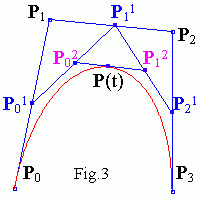Bezier spline curves
Linear Bezier spline
Linear Bezier spline is obtained by linear interpolation between
two control points P0 , P1
P(t) = (1-t)P0 +
tP1 , 0 ≤ t ≤ 1

An interactive Java applet. Drag the mouse to move the nearest control
point (a small blue square).
In the right applet window you see basis polynomials of the linear Bezier
spline. The red line is (1-t) and the green one is t.
(Sorry if your browser doesn't support
Java.)
Quadratic Bezier spline
Quadratic Bezier spline is obtained by deCasteljau algorithm as
a linear interpolation between linear interpolation between control points
P0 , P1 , P2
P01 =
(1-t)P0 + tP1 ,
P11 =
(1-t)P1 + tP2 ,
P(t) = (1-t)P01 +
tP11 =
(1-t)[(1-t)P0 + tP1] +
t[(1-t)P1 + tP2] =
(1-t)2P0 +
2(1-t)tP1 + t2P2 ,
P(t) = ∑i=0,2
Bi2(t) Pi
where Bin(t) are Bernstein polynomials
(see below).

You see basis polynomials B02(t) ,
B12(t) , B22(t) in the
right applet window (in red, green, blue, magenta... order).
By construction Bezier spline goes through its terminal control points, i.e.
P(0) = P0 ,
P(1) = P2 .
Note that P(t) subdivides the curve in two quadratic splines
(see Fig.2). The new curves match the original in position, although they
differ in parameterization. Points
P0 , P01 , P(t)
and P(t) , P11 , P1
are control points of the new small splines
(because e.g. two quadratic splines P(t) and P'(t')
determined by control points
P0 , P1 , P2 and
P0 , P01 , P(t)
both go through two points P0 , P(t) and
have the same derivative d/dt at P0 ).
Cubic Bezier spline
In a similar way one can use deCasteljau algorithm to
interpolate a curve between (n+1) control points
P0 , P1 ... Pn .
E.g. for n = 3 we get cubic Bezier spline

Points P0 , P01 ,
P02 , P(t)
and P(t) , P12 ,
P21 , P3
are control points of new small splines again.
The control points of the two new curves appear along the sides of
the systolic array (see Fig.4 below).
How to plot Bezier spline
DeCasteljau iterations
Pij =
(1-t)Pij-1 + tPi+1j-1,
j = 1, n i = 0, n-j
for n = 3 are shown on the scheme in Fig.4



This algorithm is programmed as (see
Bezier.java too)
for (j = N-1; j > 0; j--)
for (i = 0; i < j; i++){
Px[i] = (1-t)*Px[i] + t*Px[i+1]; Py[i] = (1-t)*Py[i] + t*Py[i+1];
}
where N = n+1 is number of control points.
To obtain basis polynomials recurrence relations can be used
B00(t) = 1,
Bin(t) =
(1-t)Bin-1(t) + tBi-1n-1(t),
where Brs = 0 when r < 0 or
r > s.
This algorithm is shown on the scheme in Fig.5a . It is programmed as
B[1] = 1;
for (j = 1; j < N; j++)
for (i = j+1; i > 0; i--)
B[i] = (1-t)*B[i] + t*B[i-1];
here B[0] = 0 is added for convenience, therefore i -> i+1.
Basis functions can be obtained too without "zeros" (see Fig.5)
B[0] = 1;
for (j = 0; j < n; j++)
for (i = j; i => 0; i--){
B[i+1] += t*B[i];
B[i] += (1-t)*B[i];
}
Bezier spline of degree n = 7
The general expression for Bezier spline of degree n
(order n+1) is
P(t) = ∑i=0,n
Bin(t) Pi , (*)
Bin(t) = Cni
ti(1-t)n-i ,
Cni = n! / i!(n-i)!
where Bin(t) are
Bernstein
polynomials.
From deCasteljau algorithm and Fig.4' it follows, that the control point
P1 appears in P(t) with coefficient
t(1-t)2 + (1-t)t(1-t) + (1-t)2t
= 3t(1-t)2.
We see from (*) that this coefficient is B13
too. As since we get the same B13 =
3t(1-t)2 value from Fig.5', therefore deCasteljau iterations
are equivalent to formula (*).


Further you can read more formal proof of the deCasteljau algorithm in
More Bezier splines Math or
go directly to Interpolating Lagrange curve.
Contents
Next: More Bezier splines Math
updated 7 August 2001







